A Fitted Back Gown
in a Reproduction 1780 Cotton Print
Oh my. Was September really the last Threaded Bliss we did? That's minorly embarrassing. It certainly isn't a case of not having anything new to share, but between creating items for the Shop, finishing up some commission projects, and doing some "real work" in between, we've been so prodigiously busy that the blog has slipped silently by the wayside. I had to laugh this morning when I saw that Samantha sent up a similar cry, and all I could think was, "Oh, I'm *so* glad we're not alone in this blogging backlog!"
So...here's the beginning of what I hope to be a quick succession of make-up-for-lost-time posts! This gown was finished back in January of 2013 and I wore it a number of times over the past year. Unfortunately, as these wearings included a couple of school programs, a dance, and our town's 225th anniversary parade, I didn't manage to get any pictures of it at all. During the Christmas trip to Williamsburg, then, I made it my mission to finally get some quality proof that yes, indeed, I have finished this gown, and yes, indeed, I have actually worn it!
The pattern: Draped by Ashley at a Burnley and Trowbridge workshop in November 2012.
Inspirations: The inspiration for this gown was the fabric, which, as I will detail below, is reproduction exactly from a cotton gown in the collections of Colonial Williamsburg (acc. no. 1991-450). The gown was featured in Linda Baumgarten's What Clothes Reveal (pp. 48-9).
1780 cotton print gown (acc. no. 1991-450).
Image linked from Colonial Williamsburg's Online Collections.
Construction details: Since the construction process of the gown was partially described in the original workshop post, and as it is exactly the same as all of our previous fitted-back gowns, I won't spend any time reiterating those details here.
The most challenging part of making this gown (and the reason I saved this fabric specifically for the workshop!) was matching all the viney curves on both the front and the back. I had forgotten to bring a picture of the original gown with me to the workshop, but of course Janea had the benefit of experience of having already made a gown out of this fabric and she worked her magic figuring out how to make the printed design balance and flow as it ideally should. I'm so chuffed at how perfectly it came out, thanks to her expertise!
The front of the gown...
...and the back pleats.
Here are a couple detail shots, including the back waistline,
the pleating of the skirts,
the top-stitched back pleating that helps to fit the gown closely to the back of the body,
and a detail of the shoulder and sleeve from the back.
The interior of the bodice reveals the construction process of the gown, with the stitching of the back pleats visible, along with the overlapped front linings,
as well as the unfinished armscyes, common in 18th-century gown construction.
The edge of the bodice neckline and center fronts are finished by turning the edges in towards each other.
The fabric: As I mentioned above, the fabric is part of Colonial Williamsburg's exclusive line of fabrics that are reproduced from pieces in their collection. This particular one is taken from the block printed and penciled English cotton used on a fitted-back gown dating to 1780 (CW acc. no. 1991-450).
An eerily similar English chintz textile appears in Barbara Johnson's album (V&A acc. no. T.219-1973), and her dating reaffirms the 1780 date of the CW piece. Johnson records that she purchased her fabric in June of 1781 and paid thirteen shillings a yard for it. I still can't get over how very similar the motifs are.
Finishing the look: The trouble with only having a single set of photos to share with an outfit is that they don't give any sense of the sheer variety of ways that I've worn this gown. For one, it's got several other petticoats that look splendid with it (you can see one in the workshop photos), and for another, I regret that I decided to leave my neckerchief out when I wore this for the pictures because it obscures the front of the gown. The front is visible in the dance video, but not to any real satisfying degree because it's so far away (and moving!). I suppose this just means that a "Threaded Bliss Postscript" post is necessary in the near future! :-)
When I wore the gown at Christmas, I accessorized it with a windowpane checked linen neck handkerchief, left untucked and secured in front by a breastknot of purple/yellow changeable silk taffeta. A string of deep purple glass beads further underscored the "best" middling impression suggested by the gown's textile.
I also added my favorite hat, which is trimmed, edged, lined, and tied in a blue/green changeable silk taffeta, and my B and T red shoes. Somehow, both accessories just seem to coordinate so perfectly with every outfit. I especially love wearing them together!
A set of removable windowpane checked white linen ruffles - part of the suit of kerchief, apron, and ruffles - are basted into the sleeves.
In the pictures, I have the gown drawn up through two sets of interior loops and ties to create a double draped look, giving a bit of extra body to the skirts. This feature it copied from the original inspiration gown.
These ties can be easily let down to allow the skirt to hang free. Next time I wear the gown, I'll be sure to get a view of the back left undraped.
Many more photos can be found in this project's flickr set. Stay tuned for a Threaded Bliss Postscript for more variations on this outfit soon!


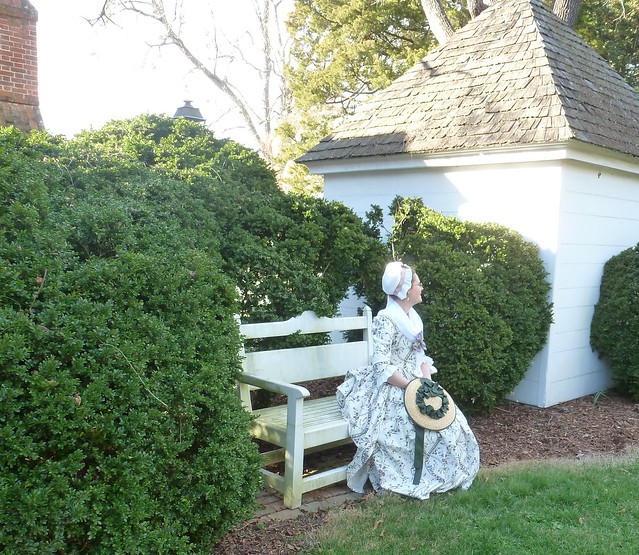



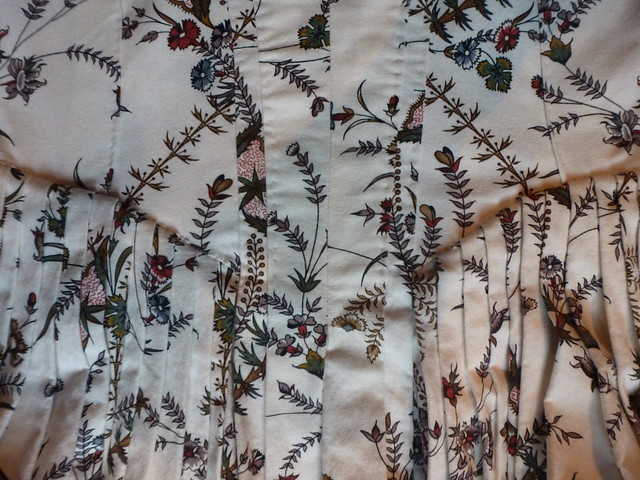
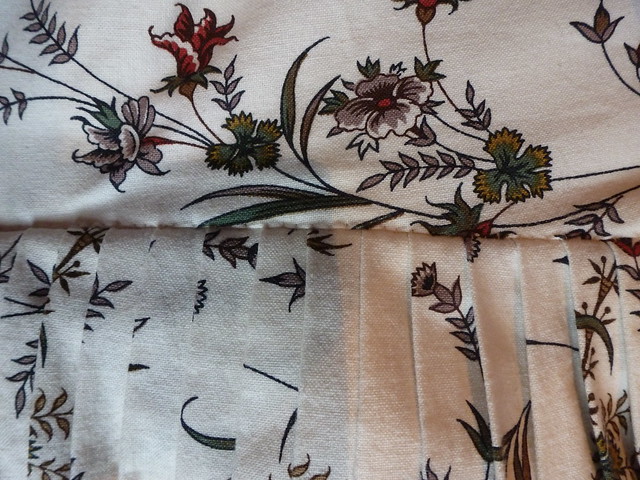
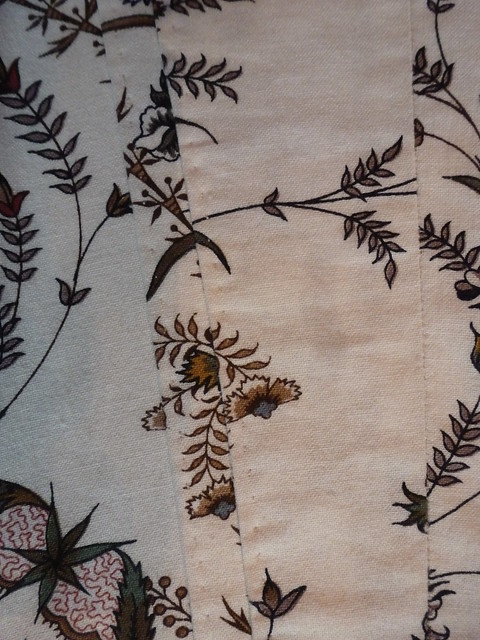
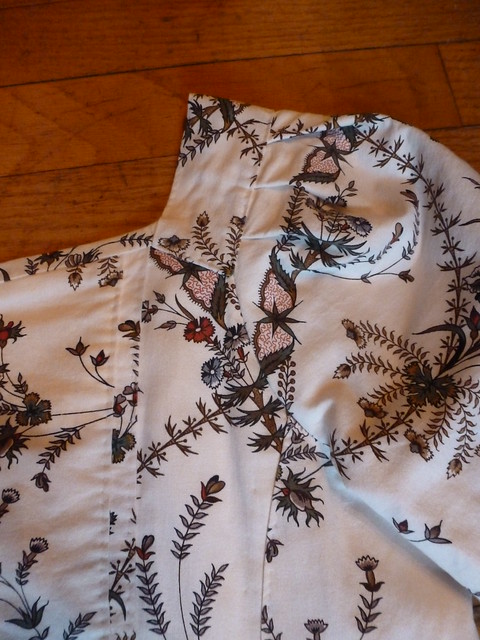
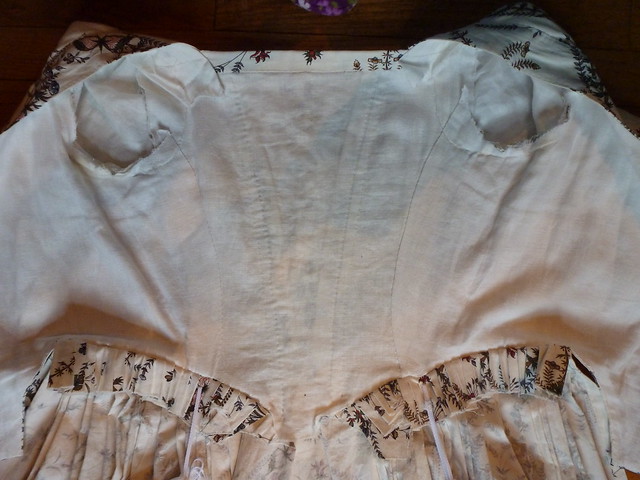
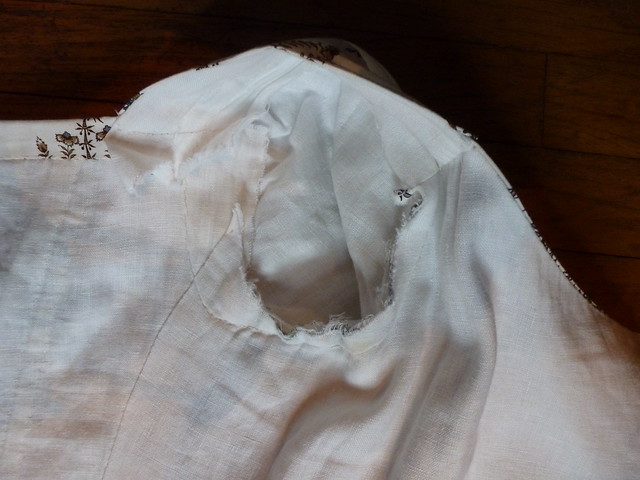
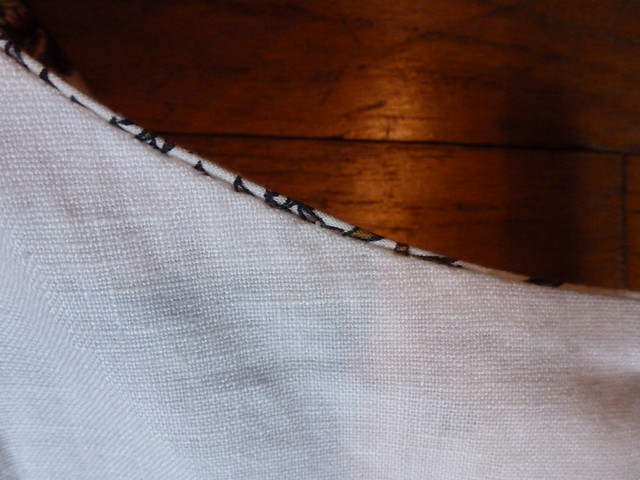

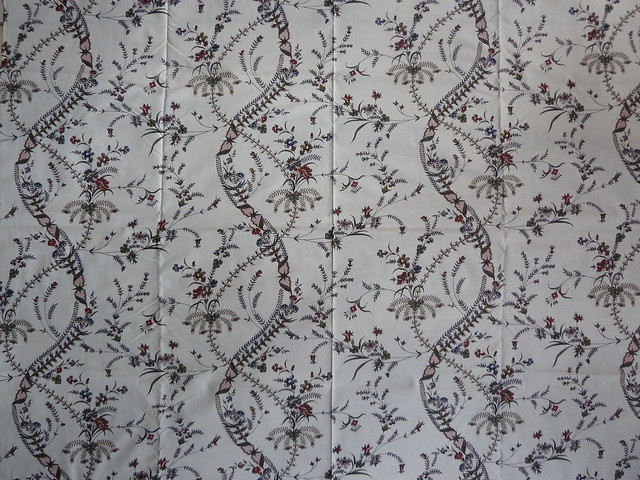

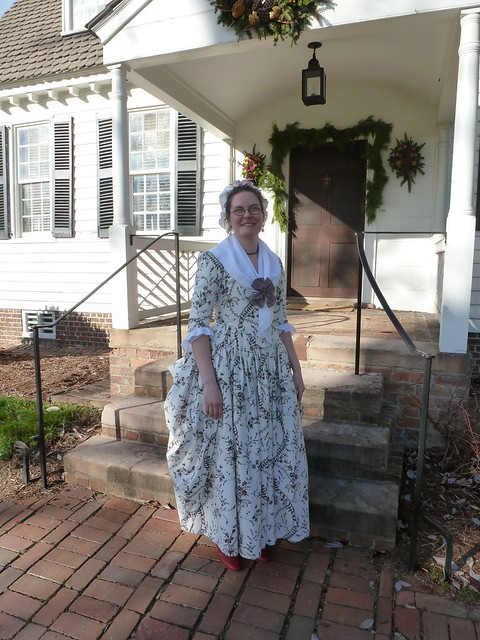
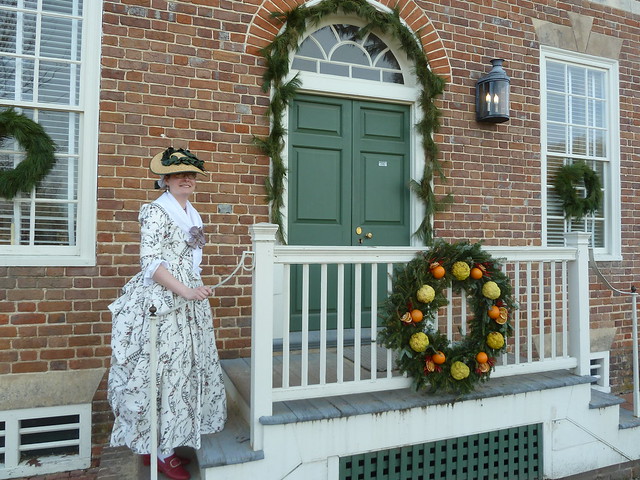
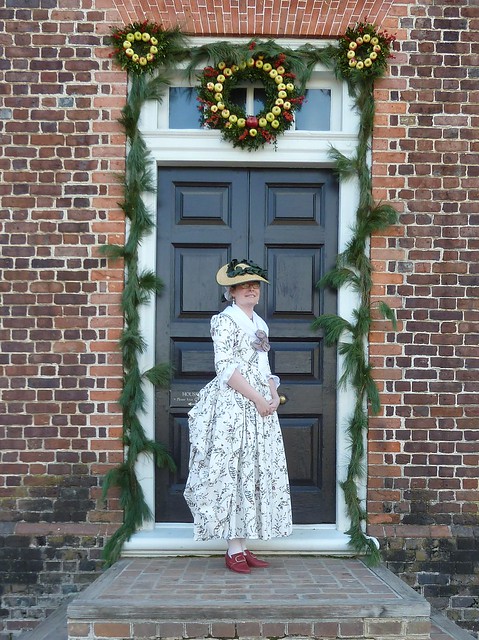
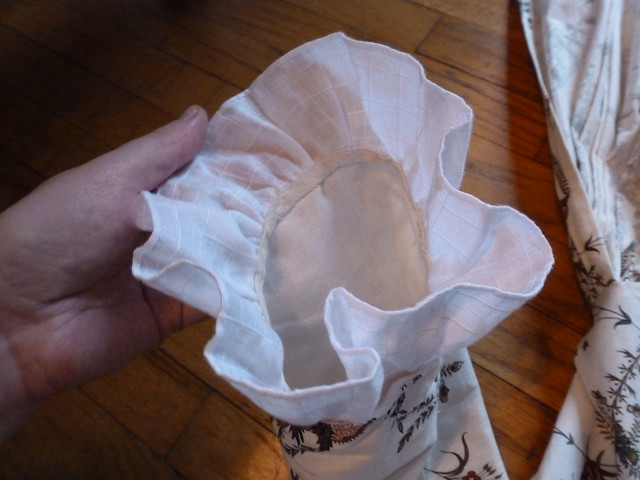
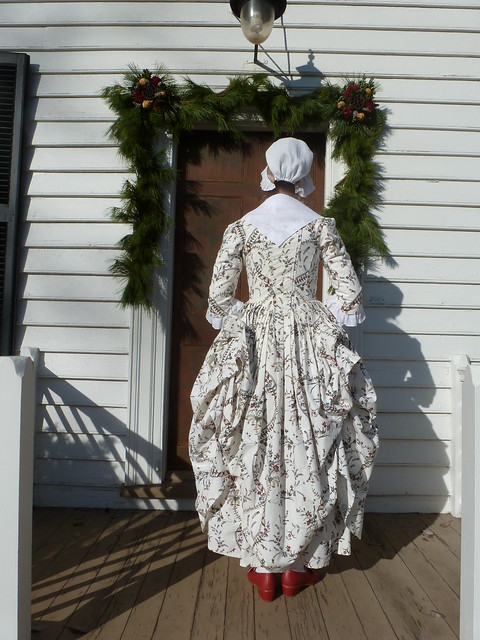
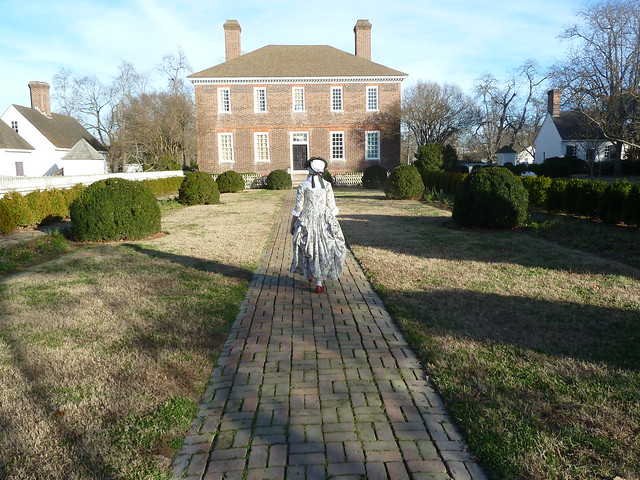
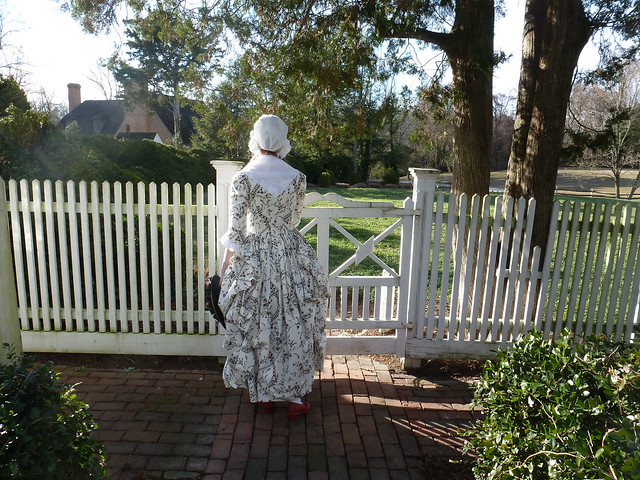
What a beautiful gown! You must be very proud of it!
ReplyDeleteAnother wonderfully made gown. Excellent work matching the print on the gown's front and back. I know what a challenge it can be as there was much fussing when I made my purple and white cotton gown. With more research available now on period prints I hope there will be even more reproduction fabrics being sold in the future.
ReplyDelete-Emily
Fabulous job- the design placement on the front is perfect! :-)
ReplyDeleteI have this fabric, too! It's been sitting around for, oh- 4 years? I hate admitting that. :-/ Someday I'll get around to making it!
Thanks, ladies! I was quite chuffed with how the print eventually went together, though much of the success of that was through the expert guidance of Janea! The fabric's design is a bit different from the original, which makes it impossible to exactly replicate the inspiration gown when it comes to arranging the curves and swirls of the print. But in the end, I didn't mind all that because I love how it came out! :-)
ReplyDeleteHere here, Emily! Yes PLEASE let's see more printed cottons available on the market this year!!!!
Lily - I must have sat on this fabric for at least 2 years before the workshop opportunity came up and I finally decided it was time to bite the bullet and cut into it! I was terrified. But I have complete and total confidance in you - I'm sure whatever you come up with will be simply brilliant (as always!)! I'll anxiously await news that the fabric is creeping out of the stash and preparing for it's big debut!
Oh my word!!! I totally did a double, triple, and quadruple take! Your gown is so very much like the original it is spooky! What a wonderful project you undertook and did with great success! Very well done indeed!!
ReplyDeleteBlessings!
Gina
I'm glad you got it exactly the way you wanted it. =)
ReplyDeleteLaurie
It looks fantastic. Can I ask is the bodice boned at all?
ReplyDeleteHi Lady D! No, the bodice isn't boned. While you do occassionally see boned gown bodices in the 1780s, they're usually of the quarter back style, with only very minimal boning to help support and smooth the multiple back seams. That said, with well-fitted stays and a well-cut bodice, you really don't need boning because the stays do all of the support work for you! :-)
ReplyDelete